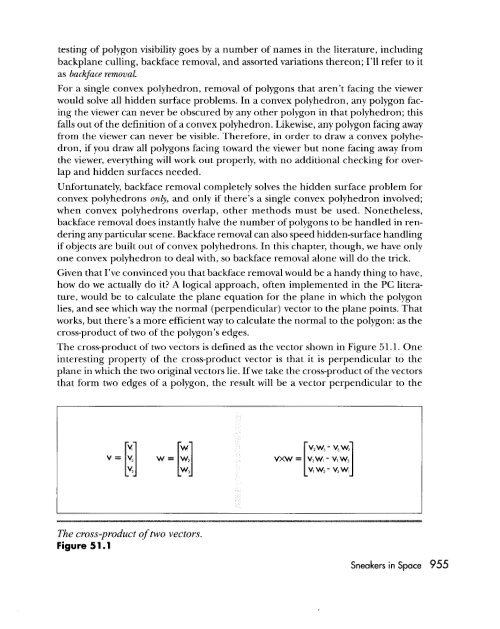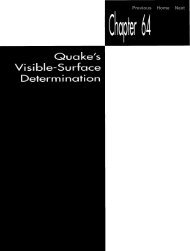sneakers in space
sneakers in space
sneakers in space
Create successful ePaper yourself
Turn your PDF publications into a flip-book with our unique Google optimized e-Paper software.
test<strong>in</strong>g of polygon visibility goes by a number of names <strong>in</strong> the literature, <strong>in</strong>clud<strong>in</strong>g<br />
backplane cull<strong>in</strong>g, backface removal, and assorted variations thereon; I’ll refer to it<br />
as backface removal.<br />
For a s<strong>in</strong>gle convex polyhedron, removal of polygons that aren’t fac<strong>in</strong>g the viewer<br />
would solve all hidden surface problems. In a convex polyhedron, any polygon fat<strong>in</strong>g<br />
the viewer can never be obscured by any other polygon <strong>in</strong> that polyhedron; this<br />
falls out of the def<strong>in</strong>ition of a convex polyhedron. Likewise, any polygon fac<strong>in</strong>g away<br />
from the viewer can never be visible. Therefore, <strong>in</strong> order to draw a convex polyhedron,<br />
if you draw all polygons fac<strong>in</strong>g toward the viewer but none fac<strong>in</strong>g away from<br />
the viewer, everyth<strong>in</strong>g will work out properly, with no additional check<strong>in</strong>g for overlap<br />
and hidden surfaces needed.<br />
Unfortunately, backface removal completely solves the hidden surface problem for<br />
convex polyhedrons only, and only if there’s a s<strong>in</strong>gle convex polyhedron <strong>in</strong>volved;<br />
when convex polyhedrons overlap, other methods must be used. Nonetheless,<br />
backface removal does <strong>in</strong>stantly halve the number of polygons to be handled <strong>in</strong> render<strong>in</strong>g<br />
any particular scene. Backface removal can speed also hidden-surface handl<strong>in</strong>g<br />
if objects are built out of convex polyhedrons. In this chapter, though, we have only<br />
one convex polyhedron to deal with, so backface removal alone will do the trick.<br />
Given that I’ve conv<strong>in</strong>ced you that backface removal would be a handy th<strong>in</strong>g to have,<br />
how do we actually do it? A logical approach, often implemented <strong>in</strong> the PC literature,<br />
would be to calculate the plane equation for the plane <strong>in</strong> which the polygon<br />
lies, and see which way the normal (perpendicular) vector to the plane po<strong>in</strong>ts. That<br />
works, but there’s a more efficient way to calculate the normal to the polygon: as the<br />
cross-product of two of the polygon’s edges.<br />
The cross-product of two vectors is def<strong>in</strong>ed as the vector shown <strong>in</strong> Figure 51.1. One<br />
<strong>in</strong>terest<strong>in</strong>g property of the cross-product vector is that it is perpendicular to the<br />
plane <strong>in</strong> which the two orig<strong>in</strong>al vectors lie. If we take the cross-product of the vectors<br />
that form two edges of a polygon, the result will be a vector perpendicular to the<br />
The cross-product of two vectors.<br />
Figure 5 1.1<br />
Sneakers <strong>in</strong> Space 955
















